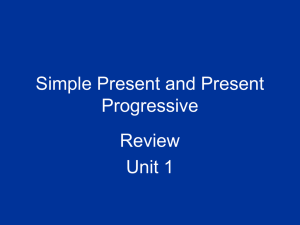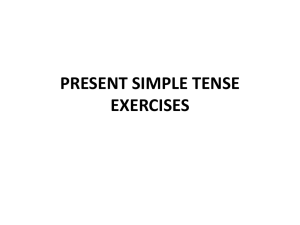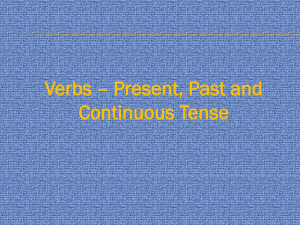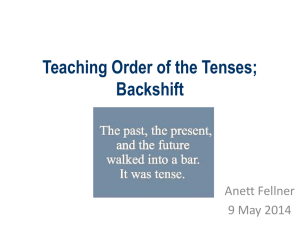Brown`s Language Stages
advertisement
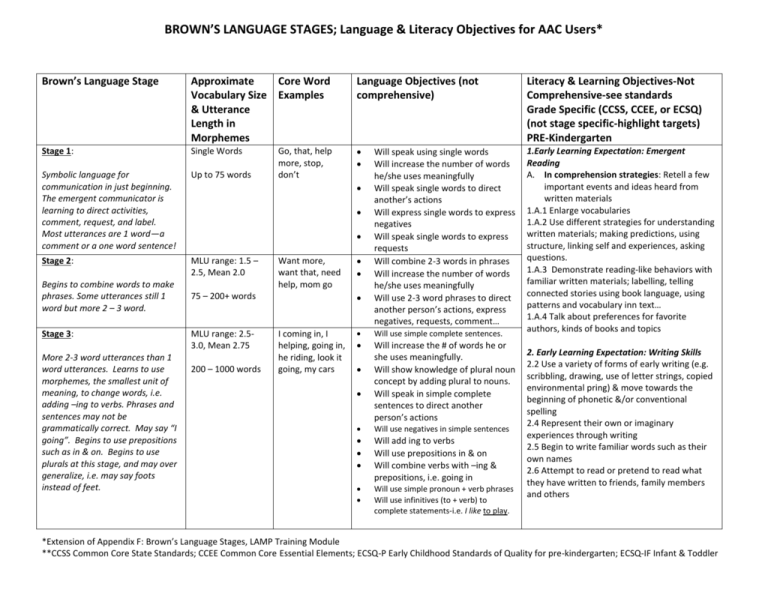
BROWN’S LANGUAGE STAGES; Language & Literacy Objectives for AAC Users* Brown’s Language Stage Approximate Core Word Vocabulary Size Examples & Utterance Length in Morphemes Language Objectives (not comprehensive) Literacy & Learning Objectives-Not Comprehensive-see standards Grade Specific (CCSS, CCEE, or ECSQ) (not stage specific-highlight targets) PRE-Kindergarten Stage 1: Single Words Symbolic language for communication in just beginning. The emergent communicator is learning to direct activities, comment, request, and label. Most utterances are 1 word—a comment or a one word sentence! Up to 75 words Stage 2: MLU range: 1.5 – 2.5, Mean 2.0 1.Early Learning Expectation: Emergent Reading A. In comprehension strategies: Retell a few important events and ideas heard from written materials 1.A.1 Enlarge vocabularies 1.A.2 Use different strategies for understanding written materials; making predictions, using structure, linking self and experiences, asking questions. 1.A.3 Demonstrate reading-like behaviors with familiar written materials; labelling, telling connected stories using book language, using patterns and vocabulary inn text… 1.A.4 Talk about preferences for favorite authors, kinds of books and topics Begins to combine words to make phrases. Some utterances still 1 word but more 2 – 3 word. Stage 3: More 2-3 word utterances than 1 word utterances. Learns to use morphemes, the smallest unit of meaning, to change words, i.e. adding –ing to verbs. Phrases and sentences may not be grammatically correct. May say “I going”. Begins to use prepositions such as in & on. Begins to use plurals at this stage, and may over generalize, i.e. may say foots instead of feet. Go, that, help more, stop, don’t Want more, want that, need help, mom go 75 – 200+ words MLU range: 2.53.0, Mean 2.75 200 – 1000 words I coming in, I helping, going in, he riding, look it going, my cars Will speak using single words Will increase the number of words he/she uses meaningfully Will speak single words to direct another’s actions Will express single words to express negatives Will speak single words to express requests Will combine 2-3 words in phrases Will increase the number of words he/she uses meaningfully Will use 2-3 word phrases to direct another person’s actions, express negatives, requests, comment… Will use simple complete sentences. Will increase the # of words he or she uses meaningfully. Will show knowledge of plural noun concept by adding plural to nouns. Will speak in simple complete sentences to direct another person’s actions Will use negatives in simple sentences Will add ing to verbs Will use prepositions in & on Will combine verbs with –ing & prepositions, i.e. going in Will use simple pronoun + verb phrases Will use infinitives (to + verb) to complete statements-i.e. I like to play. 2. Early Learning Expectation: Writing Skills 2.2 Use a variety of forms of early writing (e.g. scribbling, drawing, use of letter strings, copied environmental pring) & move towards the beginning of phonetic &/or conventional spelling 2.4 Represent their own or imaginary experiences through writing 2.5 Begin to write familiar words such as their own names 2.6 Attempt to read or pretend to read what they have written to friends, family members and others *Extension of Appendix F: Brown’s Language Stages, LAMP Training Module **CCSS Common Core State Standards; CCEE Common Core Essential Elements; ECSQ-P Early Childhood Standards of Quality for pre-kindergarten; ECSQ-IF Infant & Toddler BROWN’S LANGUAGE STAGES; Language & Literacy Objectives for AAC Users* Stage 4: Sentence forms increase to include yes/no questions and WH questions. Learns to use common past tense verbs not ending in –ed, such as “saw”. Later on, the person will become aware of the grammar rule that most past tense verbs end in –ed, & may over generalize, i.e. “comed” & “goed”. Begins to use possessive endings, i.e. “cat’s ball”. Linking verbs that are not in contractions also appear this stage; am, is… Stage 5: Learns to use the articles “a” and “the”. The concept of past tense becomes more refined. They learn that some verbs are irregular and don’t use –ed as a past tense ending. Begins to use verbs that end in –s for third person regular present tense. Range: 3.0 – 3.75 Mean: 3.5 I saw bird. Daddy’s car, car goed, I fell down, It is hot, Where is it?, Don’t want 1,000 to 2,000 words Range: 3.75 – 4.5 Mean: 4.0 They are coming, They’re not here The bird in tree, It’s time to go. My dog barks. Will increase the number of words he or she uses meaningfully Will ask simple –WH questions Will use common irregular verbs to indicate past tense Will use linking verbs is and are with increasing accuracy Will use adjectives in simple sentences to describe things Will use negative pronoun + verb phrase (no hitting) Will increase the number of words he or she uses meaningfully Will use the articles a and the in sentences Will use past tense linking verbs was & were with increasing frequency & accuracy Will use past tense verbs ending in –ed with increasing frequency and accuracy Will use verbs ending in –s with third person subject in sentences with increasing frequency and accuracy Will add –s to nouns to show possession Will begin to use “going to” and “will” to express future actions 3. Early Learning Expectation: Spoken (AAC) Language: Expressive 3.1 Will use language for a variety of purposes (express feelings, ask questions, talk about experiences, ask for what they need, respond to others) 3.2 Will show increasing comfort and confidence when communicating. 3.4 Continue to develop vocabulary by using words learned from stories and other sources in conversations. 3.5 Speak in increasingly more complex combinations of words and in sentences. 3.6 Understand the roles of participants in conversations (taking turns and relating comments to what is said; asking relevant questions) 3.10 Show progress in learning alternative communication strategies. *Extension of Appendix F: Brown’s Language Stages, LAMP Training Module **CCSS Common Core State Standards; CCEE Common Core Essential Elements; ECSQ-P Early Childhood Standards of Quality for pre-kindergarten; ECSQ-IF Infant & Toddler BROWN’S LANGUAGE STAGES; Language & Literacy Objectives for AAC Users* *Extension of Appendix F: Brown’s Language Stages, LAMP Training Module **CCSS Common Core State Standards; CCEE Common Core Essential Elements; ECSQ-P Early Childhood Standards of Quality for pre-kindergarten; ECSQ-IF Infant & Toddler


